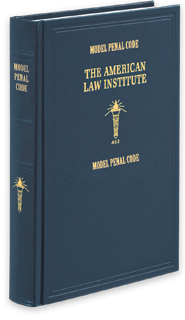
Sentencing
This work addresses the many changes in sentencing philosophy and practice that have taken place in the more than 40 years since these matters were first addressed in the Model Code. The project considers the contemporary controversy about the appropriate length of American criminal sentences and the present widespread dissatisfaction with the rules and procedures used to determine them. More information on the Code and Commentaries.
Purchase the book below or complete this form to sign up to be notified about all new ALI publications.
Reporter:
Kevin R. Reitz, University of Minnesota Law School
Associate Reporter:
Cecelia Klingele, University of Wisconsin Law School
- Model Penal Code: Sentencing, Official Text1071 pages, 2023, #1MPCSOT
This work revisits the sentencing provisions of the Model Penal Code in light of the many changes in sentencing philosophy and practice that have taken place in the more than 50 years since the Code was first developed. It replaces about half of the original Code and contains exhaustive research into best practices across the 50 states as well as a deep examination of academic literature. In addition to setting forth a comprehensive model for state legislatures, this publication provides invaluable materials for public-policy experts and academics.
More details and content summaryXTABLE OF CONTENTS
Foreword
Reporters’ Introduction
Part I. General Provisions
Article 1. Preliminary
1.02(2). Purposes of Sentencing and the Sentencing System
Article 6. Authorized Dispositions
6.01. Grading of Felonies and Misdemeanors
6.02. Authorized Dispositions for Individuals
6.03. Deferred Prosecution
6.04. Deferred Adjudication
6.05. Probation
6.06. Economic Sanctions; General Provisions
6.07. Victim Restitution
6.08. Fines
6.09. Asset Forfeitures
6.10. Costs, Fees, and Assessments
6.11. Incarceration
6.12. Credit Against the Sentence for Time Spent in Custody
6.13. Postrelease Supervision
6.14. Sentencing of Offenders Under the Age of 18
6.15. Violations of Probation or Postrelease Supervision
6.16. Victim-Offender Conferencing; Principles for Legislation (see Appendix A)
Article 7. Collateral Consequences of Criminal Conviction
7.01. Definitions
7.02. Sentencing Guidelines and Collateral Consequences
7.03. Voting and Jury Service
7.04. Notification of Collateral Consequences; Order of Relief
7.05. Orders of Relief for Convictions from Other Jurisdictions; Relief Following the Termination of a Sentence
7.06. Certificate of Restoration of Rights
Article 8. Sentencing Commission
8.01. Establishment and Purposes of Sentencing Commission
8.02. Membership of Sentencing Commission
8.03. Staff of Sentencing Commission
8.04. Initial Responsibilities of Sentencing Commission
8.05. Ongoing Responsibilities of Sentencing Commission
8.06. Community Corrections Strategy
8.07. Projections Concerning Fiscal Impact, Correctional Resources, and Demographic Impacts
8.08. Ancillary Powers of Sentencing Commission
8.09. Omnibus Review of Sentencing System
Article 9. Sentencing Guidelines
9.01. Definitions
9.02. Framework for Sentencing Guidelines
9.03. Purposes of Sentencing and Sentencing Guidelines
9.04. Presumptive Guidelines and Departures
9.05. Eligible Sentencing Considerations
9.06. Use of Criminal History
9.07. Multiple Sentences; Concurrent and Consecutive Terms
9.08. Evidence-Based Sentencing; Offender Treatment Needs and Risk of Reoffending
9.09. Offenses Not Covered by Sentencing Guidelines
9.10. Effective Date of Sentencing Guidelines and Amendments
Article 10. Judicial Sentencing Authority
10.01. Judicial Authority to Individualize Sentences
10.02. Choices Among Sanctions
10.03. Eligible Sentencing Considerations
10.04. Sentences upon Multiple Convictions
10.05. Sentencing Proceedings; Presentence Investigation and Report
10.06. Sentencing Proceedings; Findings of Fact and Conclusions of Law
10.07. Sentencing Proceedings; Jury Factfinding
10.08. Sentencing Proceedings; Victims’ Rights
10.09. Sentence Modification
10.10. Appellate Review of Sentences
Article 11. Prison Release; Correctional Populations Exceeding Capacity
11.01. Good-Time Reductions of Prison Terms; Reductions for Program Participation
11.02. Modification of Long-Term Prison Sentences; Principles for Legislation (see Appendix A)
11.03. Modification of Prison Sentences in Circumstances of Advanced Age, Physical or Mental Infirmity, Exigent Family Circumstances, or Other Compelling Reasons
11.04. Control of Correctional Populations That Exceed Operational Capacity; Principles for Legislation (see Appendix A)
Appendixes
Appendix A. Principles for Legislation
Article 6. Authorized Dispositions
6.16. Victim-Offender Conferencing; Principles for Legislation
Article 11. Prison Release; Correctional Populations Exceeding Capacity
11.02. Modification of Long-Term Prison Sentences; Principles for Legislation
11.04. Control of Correctional Populations That Exceed Operational Capacity; Principles for Legislation
Appendix B. Institutional Structure of the Sentencing System
Appendix C. The Question of Parole-Release Authority
Appendix D. Victims’ Roles in the Sentencing Process